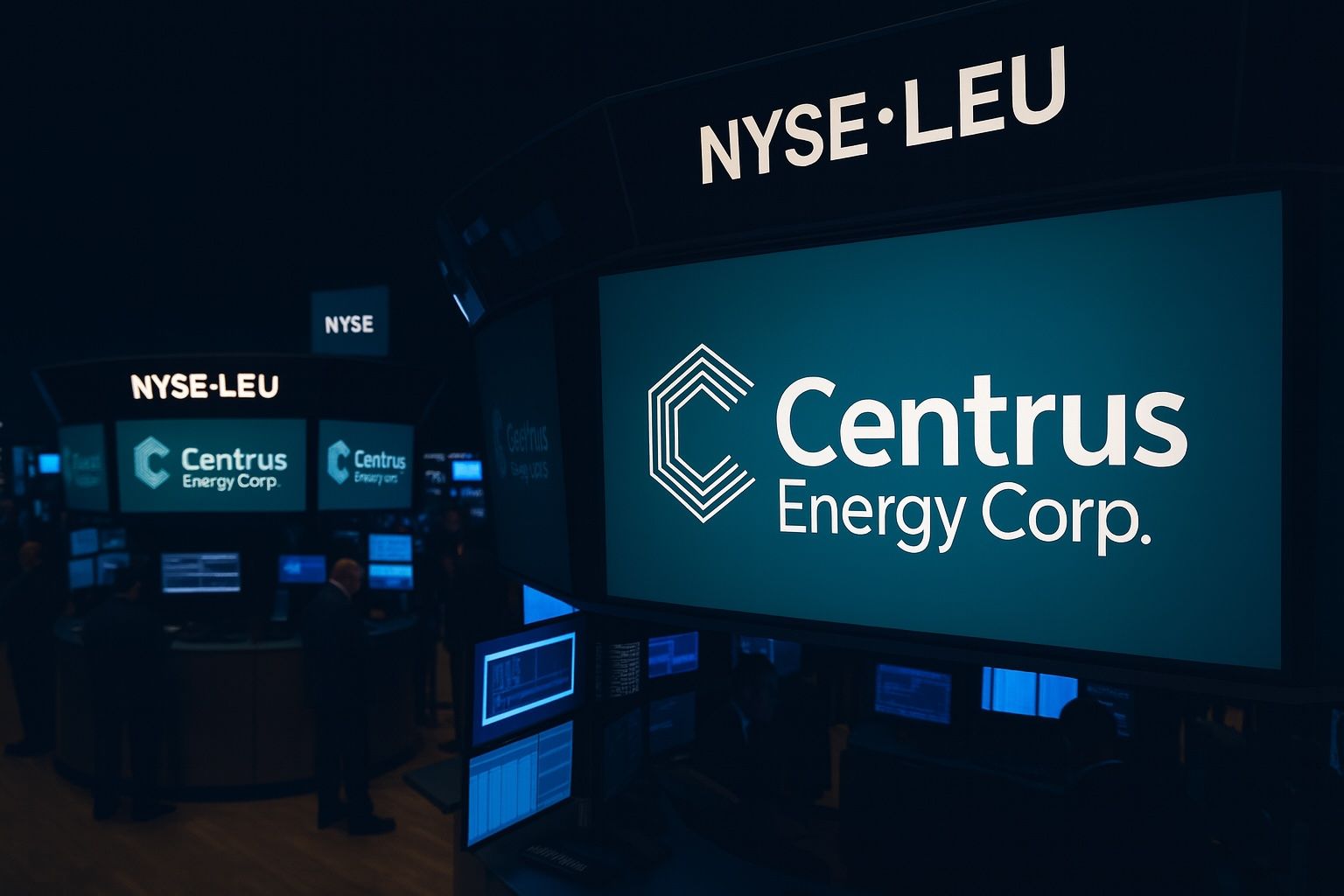- Record Rally & Sharp Reversal: Centrus Energy Corp. (NYSE: LEU) became one of 2025’s top-performing energy stocks with a year-to-date surge of over 400% amid a uranium boom [1] [2]. However, the stock plunged nearly 20% on October 22, closing around $300 after touching record highs last week [3].
- Volatile Price Action: LEU hit an all-time intraday high near $464 on October 16, then nosedived over 35% in just a few sessions [4] [5]. On Oct. 22 alone, the stock fell from an open near $354 to ~$300 by close [6], underscoring extreme volatility as traders rapidly took profits.
- What’s Driving the Drop: Analysts attribute the pullback to profit-taking and valuation concerns after a parabolic run, as well as dilution fears from Centrus’s recent $700 million convertible note financing [7] [8]. High interest rates and a strong dollar have also pressured high-flying energy stocks, prompting some investors to rotate out of nuclear names in the short term [9].
- Financial & Industry Strength: Despite the stock volatility, Centrus’s fundamentals remain strong – the company is profitable (Q2 net income of $28.9 M on $154.5 M revenue) with robust margins and over $3.6 billion in order backlog stretching to 2040 [10]. Uranium prices are near multi-year highs (>$80/lb in late September) amid a global reactor fuel supply squeeze [11]. U.S. policy is firmly pro-nuclear: Washington banned Russian uranium imports in 2024 and is offering $3.4 billion to boost domestic fuel production, a tailwind for Centrus [12] [13].
- Outlook – Caution into Catalyst Events: Looking ahead, experts foresee continued turbulence. Wall Street’s average 12-month price target (~$240–250) sits below current levels [14], and some warn the stock “has run far ahead of fundamentals,” flagging execution risks [15]. Upcoming Q3 earnings and federal contract awards for advanced nuclear fuel are critical catalysts. Bulls argue Centrus is uniquely positioned for “decades of growth” as the only U.S.-owned uranium enricher [16] [17], but in the near term the stock may need to consolidate after its rollercoaster ride [18] [19].
LEU Stock’s Wild Ride – From Nuclear Euphoria to 20% Plunge
Centrus Energy’s stock has been on a rollercoaster in 2025, exhilarating investors with a massive rally before suffering a brutal pullback. The company’s share price skyrocketed over 400% this year amid surging nuclear enthusiasm [20]. By mid-October, LEU had spiked to an intraday high of about $464 – an astounding 9× jump from roughly $50 one year ago [21] [22]. This breathtaking rally made Centrus one of the top-performing energy stocks of 2025 [23].
However, that euphoria abruptly reversed this past week. After peaking on Oct. 16, Centrus shares gave up more than a third of their value in days. The sell-off crescendoed on October 22, when LEU plunged 20.6% in a single session to close at $299.50 [24]. The stock opened that day at $354 but free-fell amid heavy volume, marking Centrus’s worst one-day drop in recent memory. Even counting the pullback, LEU remains up roughly 300%+ year-over-year – but the swift decline has rattled investors and erased billions in market cap [25] [26].
Such whiplash volatility reflects how overheated the stock had become. Prior to the fall, Centrus was trading dramatically above its long-term trendlines – recently ~90% above its 50-day moving average and ~100% over the 200-day [27]. Classic technical signs of an overbought market were flashing (the 14-day RSI topped 75) [28], and analysts had cautioned that a near-term correction was likely after the parabolic climb [29] [30]. In late September, even minor negative news triggered profit-taking (e.g. a 4.6% dip on Sept. 24 as some traders cashed out) [31] – a warning that momentum could reverse quickly. That reversal arrived with a vengeance in the past few sessions, illustrating the downside of Centrus’s incredible run-up: big gains can evaporate just as fast when sentiment shifts.
Why Did Centrus Stock Crash? – Profit-Taking, Dilution Fears, and Valuation Jitters
The lack of any single catastrophic news event on Oct. 22 suggests the rout was driven by a confluence of factors rather than a fundamental collapse. Profit-taking was undoubtedly a major factor – with the stock up 5× in a year [32], many early investors likely decided to lock in gains. Once the momentum stalled, short-term traders piled out, accelerating the decline.
Beyond technical selling, valuation concerns have loomed large. Even before this drop, Centrus was trading at lofty multiples: over 50× earnings and 12× sales, near decade highs on those metrics [33]. Its market cap had swelled above $5.5 billion [34] for what is still a niche fuel supplier with ~$437 million in trailing revenue [35]. As one analysis put it, the stock’s valuation appeared to “have run far ahead of fundamentals,” baking in flawless execution of growth plans [36]. When a stock is priced for perfection, any hint of headwinds can send investors running.
Dilution and financing moves are one such concern. In August, Centrus raised $700 million via an upsized convertible note offering to fund its capacity expansion [37]. While the zero-coupon bond provided growth capital, it came with a catch: the notes convert to stock at an initial price of ~$229.62 [38]. With LEU trading well above that level until recently, the deal virtually guarantees an influx of new shares (up to ~3 million, ~17% dilution) if the price stays elevated. Fears that management might tap frothy market conditions for even more capital – or that heavy insider selling could occur – may have weighed on sentiment. Indeed, just the anticipation of future share issuance can pressure a red-hot stock, as savvy investors trim positions to avoid being diluted.
Macroeconomic and sector shifts also played a role. In recent weeks, rising interest rates and a strengthening U.S. dollar have prompted a rotation out of high-valuation growth stocks [39]. Small-cap energy names that had run up – like Centrus – suddenly looked less attractive compared to safer assets as borrowing costs climbed. Additionally, a renewed focus by policymakers on renewables (solar, wind) has reminded the market that nuclear isn’t the only game in town. The International Energy Agency (IEA) recently highlighted accelerated clean energy adoption, which could dampen long-term uranium demand growth [40] [41]. Whether justified or not, that narrative shift siphoned some enthusiasm from uranium-related stocks.
Finally, some company-specific jitters surfaced. Centrus is racing to scale up its uranium enrichment capacity, but any hints of delays or cost overruns can spook investors. Unconfirmed reports of minor supply chain bottlenecks and regulatory hurdles in its expansion plan raised questions about whether Centrus can meet aggressive 2026 production targets [42]. At the same time, Washington D.C. saw debate over the scope of future nuclear subsidies. A proposed federal review of nuclear energy support programs fueled worry that government contracts – a key revenue source for Centrus – could be trimmed if political priorities shift [43]. None of these risks are new, but in a stock priced for exponential growth, even small clouds on the horizon can trigger an outsized reaction.
In summary, Centrus’s steep sell-off appears to be a “perfect storm” of profit-taking after an overextended rally, anxiety about dilution and rich valuation, and broader market/headline factors tempering the nuclear euphoria [44]. As the dust settles, investors are assessing whether this is a healthy correction in a longer uptrend or the start of a deeper reset.
Big-Picture Tailwinds: Nuclear Revival, Uranium Boom, and Geopolitics
Crucially, the fundamental backdrop for Centrus’s business remains very favorable, even after the stock’s pullback. The company sits at the intersection of powerful tailwinds in the nuclear energy sector:
- Nuclear Renaissance: Around the world, nuclear power is enjoying a renaissance as a reliable, carbon-free energy source. Many countries are extending reactor lifespans and commissioning new reactors, reversing a decades-long decline in nuclear development [45]. In the U.S., both political parties have shown support for advanced nuclear technology and fuel as a cornerstone of energy strategy [46]. This shifting sentiment has dramatically improved the long-term demand outlook for uranium fuel. Centrus, as the only U.S.-owned uranium enrichment company, is uniquely positioned to benefit if this nuclear revival continues [47].
- Uranium Price Surge: The price of uranium – Centrus’s key commodity – has been climbing sharply. Spot uranium recently hit about $82.63 per pound in late September 2025, the highest level of the year and up nearly 30% from spring [48]. It remains in the high $70s as of October. This surge is driven by a widening supply-demand imbalance: more utilities are seeking fuel amid reactor restarts and new builds, while mine output and enrichment capacity are relatively constrained [49]. The uranium rally has lifted the entire sector – uranium miners (Cameco, Energy Fuels, etc.) and fuel suppliers have all spiked in 2025 [50]. Higher uranium prices directly boost Centrus’s revenue potential on its long-term contracts, and buoy investor enthusiasm for nuclear equities in general.
- Geopolitical Urgency – Russia Factor: Russia’s war in Ukraine has jolted Western countries into rethinking their reliance on Russian nuclear fuel. Historically, Russia supplied roughly 20–30% of U.S. enriched uranium [51]. But since the Ukraine invasion, that link has been severely strained. In 2024 the U.S. government banned imports of Russian uranium, and Moscow retaliated by halting its remaining exports to the U.S. [52]. This geopolitical rift means U.S. utilities can no longer count on Russian enrichment – a void that Centrus is racing to fill. Policymakers now view domestic enrichment capability as a national security priority, ending a decade of U.S. dependence on foreign suppliers [53]. The urgency to rebuild an American enrichment supply chain has never been higher, which plays directly into Centrus’s hand.
- U.S. Government Support: The U.S. Department of Energy (DOE) is backing up its pro-nuclear stance with major funding initiatives. Over $3.4 billion in federal funding has been authorized to jumpstart domestic production of both low-enriched uranium (LEU) and high-assay low-enriched uranium (HALEU, needed for new reactor designs) [54]. Centrus has submitted proposals and is vying for a large share of these grants and contracts [55]. Already, the company achieved a milestone by delivering 900 kg of HALEU fuel to the DOE in 2025 under a demonstration contract [56]. If Centrus secures additional DOE awards or appropriations for HALEU fuel in coming months, it could be a game-changer – effectively subsidizing the scale-up of its Ohio enrichment plant. Any such contract wins would be major catalysts for the stock, reinforcing the long-term growth narrative [57].
In short, the industry and policy context for Centrus is highly favorable. A confluence of factors – climate policy, energy security, and geopolitical realignment – is driving what many call a “nuclear fuel renaissance.” This backdrop helped explain why Centrus stock ran up so far, so fast. It wasn’t mere speculation; the company’s strategic importance and market opportunity truly have expanded. As America’s only domestic uranium enricher, Centrus stands to benefit from multi-decade trends if it can execute. These tailwinds remain intact despite the recent equity sell-off. However, investors must weigh these long-range positives against the execution challenges and short-term market dynamics that can affect the stock.
Wall Street’s Take – Expert Opinions and What’s Next for LEU
After the dizzying rise and fall, what do the experts say about Centrus Energy’s prospects? In general, analysts are bullish on Centrus’s business but divided on its stock valuation, especially in the near term.
Wall Street coverage of LEU has expanded this year (over a dozen analysts now follow it [58]). The consensus rating is a “Moderate Buy” – most brokerages have positive ratings (Buy/Outperform) on Centrus, reflecting its unique position in a growing niche. However, several analysts have recently tapped the brakes after the stock’s steep rally, moving to neutral or hold even as they acknowledge Centrus’s long-term potential [59]. This split viewpoint underscores the key question: is the growth story already priced in?
Price targets reveal the debate. According to MarketBeat and Investing.com data, 12-month targets on LEU range from about $108 on the low end to around $300+ at the high end [60]. The average target is roughly $240–$250 per share [61] [62]. Notably, even that “average” was below the stock’s peak levels – implying many analysts think LEU got ahead of itself when it was near $300-$400. As of this week’s drop to ~$300 and below, the stock is finally back in the vicinity of analyst fair value estimates (and still above the consensus target of ~$202 cited by some surveys [63] [64]).
Some recent analyst calls illustrate the spectrum of opinion:
- Lake Street Capital raised its price target to a Street-high $310 (Buy rating) after Q2 results, arguing Centrus could see much larger earnings if it wins government deals and expands successfully [65]. This is an aggressively bullish outlook betting on smooth execution.
- Evercore ISI is also upbeat with an $252 target (Outperform) – essentially saying the stock is worth around the low-$250s today, and further upside would depend on new positive developments [66].
- Bank of America (BofA) took a more cautious stance. BofA initiated coverage with a Buy earlier in 2025 but downgraded to Neutral in August after the stock’s huge run-up – even as they hiked their target from $160 to $285 [67]. BofA’s analyst lauded Centrus’s long-term strategy but warned that valuation had become stretched above ~$270 [68]. They essentially signaled that much of the good news was priced in, at least for now.
- Other firms like H.C. Wainwright ($300 target, Buy) and Northland Securities (~$275, Outperform) have issued bullish targets in the high-$200s [69] [70], conveying confidence that Centrus’s fundamentals can support those levels. Meanwhile, some research outfits (e.g. William Blair, UBS) moved to more neutral stances as the stock climbed, simply to wait for a better entry point [71] [72].
The bottom line from analysts: virtually everyone agrees Centrus Energy has a compelling story and significant growth opportunities in supplying fuel for a nuclear resurgence. But after the stock’s torrid ascent, opinions differ on whether it’s a buy at current levels. Many pros are in “show me” mode – positive on the company, yet wanting to see concrete progress (new contracts, expansion milestones, earnings growth) to justify sustained high valuations.
Short-Term vs. Mid-Term Outlook
In the short term (coming weeks to months), traders should expect continued volatility. Centrus has become a high-beta stock that reacts sharply to news and sector sentiment [73] [74]. The recent correction could find support around key technical levels – for instance, some chart analysts note the previous breakout zone near $265 might act as support now [75]. Indeed, LEU briefly bounced near $293 intraday on Oct. 22 after slicing through $300, hinting at dip-buyers stepping in. If the stock stabilizes around the low-$300s or high-$200s, it may consolidate as investors digest its huge year-to-date move. Upcoming events will likely drive the next leg: Centrus’s Q3 earnings report (expected in early November) will be closely watched for updates on its enrichment project timeline and any revenue surprises. Any announcement from DOE on HALEU funding awards or new utility supply contracts could also jolt the stock. Absent fresh catalysts, Centrus might trade choppily in a range as the market waits.
Looking at the mid-term (6–12 months), the stock’s trajectory will hinge on execution and newsflow. Optimists believe the recent dip could be a buying opportunity before the next climb. They argue that as Centrus actually deploys the $700M it raised to triple its enrichment capacity, the company’s earnings power will expand dramatically in coming years – potentially validating the bulls’ higher targets. If nuclear energy demand keeps rising and Centrus secures a big slice of government funding, LEU could resume its uptrend. On the other hand, skeptics caution that the stock might have already priced in best-case scenarios. Any stumble – whether construction delays, budget overruns, or policy hiccups – could lead to further downside. The consensus earnings estimate for the full year 2025 is only about $2.63 per share [76] (reflecting a dip from 2024 due to timing of contracts). That means even at ~$300, the stock is trading near 115× this year’s expected earnings, a rich multiple. There is little margin for error.
Several analysts have explicitly advised patience, noting that Centrus’s story is compelling but will take time to play out [77] [78]. The company must successfully scale production by 2026 and ramp up deliveries to fulfill its multi-billion dollar order backlog [79]. If it does so, earnings could inflect higher and justify a higher stock price mid-term. If not, the stock may continue to see-saw or even retreat as reality catches up to the hype. As GuruFocus observed, Centrus still enjoys a strong balance sheet and solid profitability metrics (Altman Z-score 5.6, net margin ~24% [80]), which provides a cushion. The firm isn’t in financial distress – this is about growth expectations.
For now, investors would be wise to stay nimble. Volatility cuts both ways: just as LEU’s ascent was extraordinarily steep, its correction has been swift. Further swings are likely. Watching the nuclear fuel news cycle is key – positive headlines (e.g. new contracts, policy support) could quickly reignite the rally, while negative developments (e.g. competitor advances, uranium price drops) could add pressure. Most analysts agree on one thing: Centrus Energy’s long-term potential is real, but after the wild ride of 2025, the stock’s next chapter will depend on proving that potential step by step [81]. Investors riding this nuclear wave should buckle up for more twists and turns ahead.
Sources: Centrus Energy stock data and historical prices [82] [83]; GuruFocus News (Oct. 22, 2025) [84] [85]; TechStock² Nuclear Energy reports [86] [87] [88] [89]; AInvest market analysis [90] [91]; Centrus Energy press releases [92] [93]; MarketBeat and Investing.com analyst surveys [94] [95].
References
1. ts2.tech, 2. ts2.tech, 3. www.investing.com, 4. www.investing.com, 5. www.investing.com, 6. www.investing.com, 7. www.prnewswire.com, 8. www.prnewswire.com, 9. www.ainvest.com, 10. ts2.tech, 11. ts2.tech, 12. ts2.tech, 13. ts2.tech, 14. ts2.tech, 15. ts2.tech, 16. ts2.tech, 17. ts2.tech, 18. ts2.tech, 19. www.ainvest.com, 20. ts2.tech, 21. www.investing.com, 22. ts2.tech, 23. ts2.tech, 24. www.investing.com, 25. www.gurufocus.com, 26. www.gurufocus.com, 27. ts2.tech, 28. ts2.tech, 29. ts2.tech, 30. ts2.tech, 31. ts2.tech, 32. ts2.tech, 33. www.gurufocus.com, 34. www.gurufocus.com, 35. www.gurufocus.com, 36. ts2.tech, 37. www.prnewswire.com, 38. www.prnewswire.com, 39. www.ainvest.com, 40. www.ainvest.com, 41. www.ainvest.com, 42. www.ainvest.com, 43. www.ainvest.com, 44. www.ainvest.com, 45. ts2.tech, 46. ts2.tech, 47. ts2.tech, 48. www.ans.org, 49. ts2.tech, 50. ts2.tech, 51. ts2.tech, 52. ts2.tech, 53. ts2.tech, 54. ts2.tech, 55. ts2.tech, 56. ts2.tech, 57. ts2.tech, 58. ts2.tech, 59. ts2.tech, 60. ts2.tech, 61. ts2.tech, 62. ts2.tech, 63. www.marketbeat.com, 64. www.marketbeat.com, 65. ts2.tech, 66. ts2.tech, 67. ts2.tech, 68. ts2.tech, 69. ts2.tech, 70. www.marketbeat.com, 71. www.marketbeat.com, 72. www.marketbeat.com, 73. ts2.tech, 74. ts2.tech, 75. ts2.tech, 76. www.marketbeat.com, 77. ts2.tech, 78. ts2.tech, 79. ts2.tech, 80. www.gurufocus.com, 81. www.ainvest.com, 82. www.investing.com, 83. www.investing.com, 84. www.gurufocus.com, 85. www.gurufocus.com, 86. ts2.tech, 87. ts2.tech, 88. ts2.tech, 89. ts2.tech, 90. www.ainvest.com, 91. www.ainvest.com, 92. www.prnewswire.com, 93. www.prnewswire.com, 94. ts2.tech, 95. www.marketbeat.com










